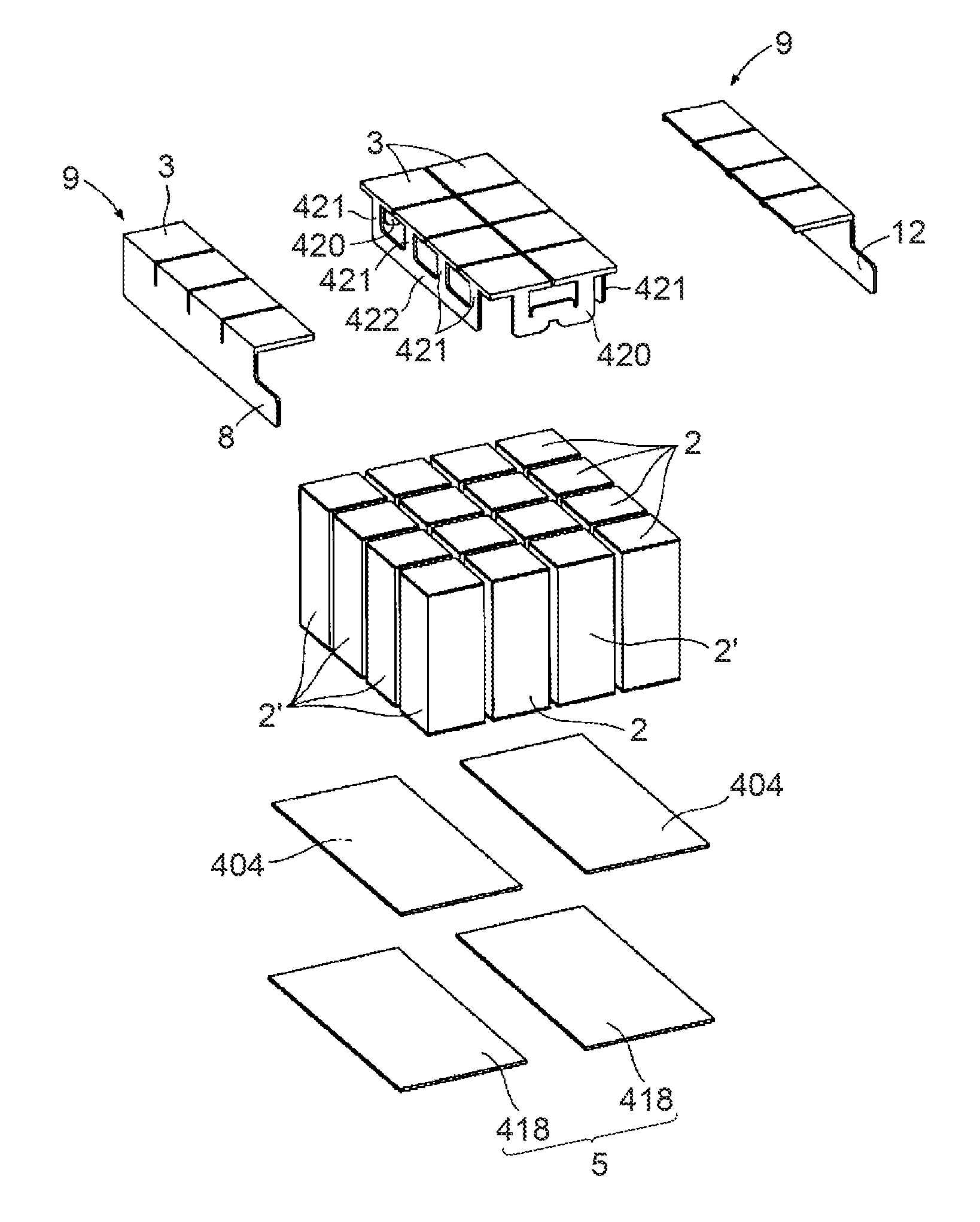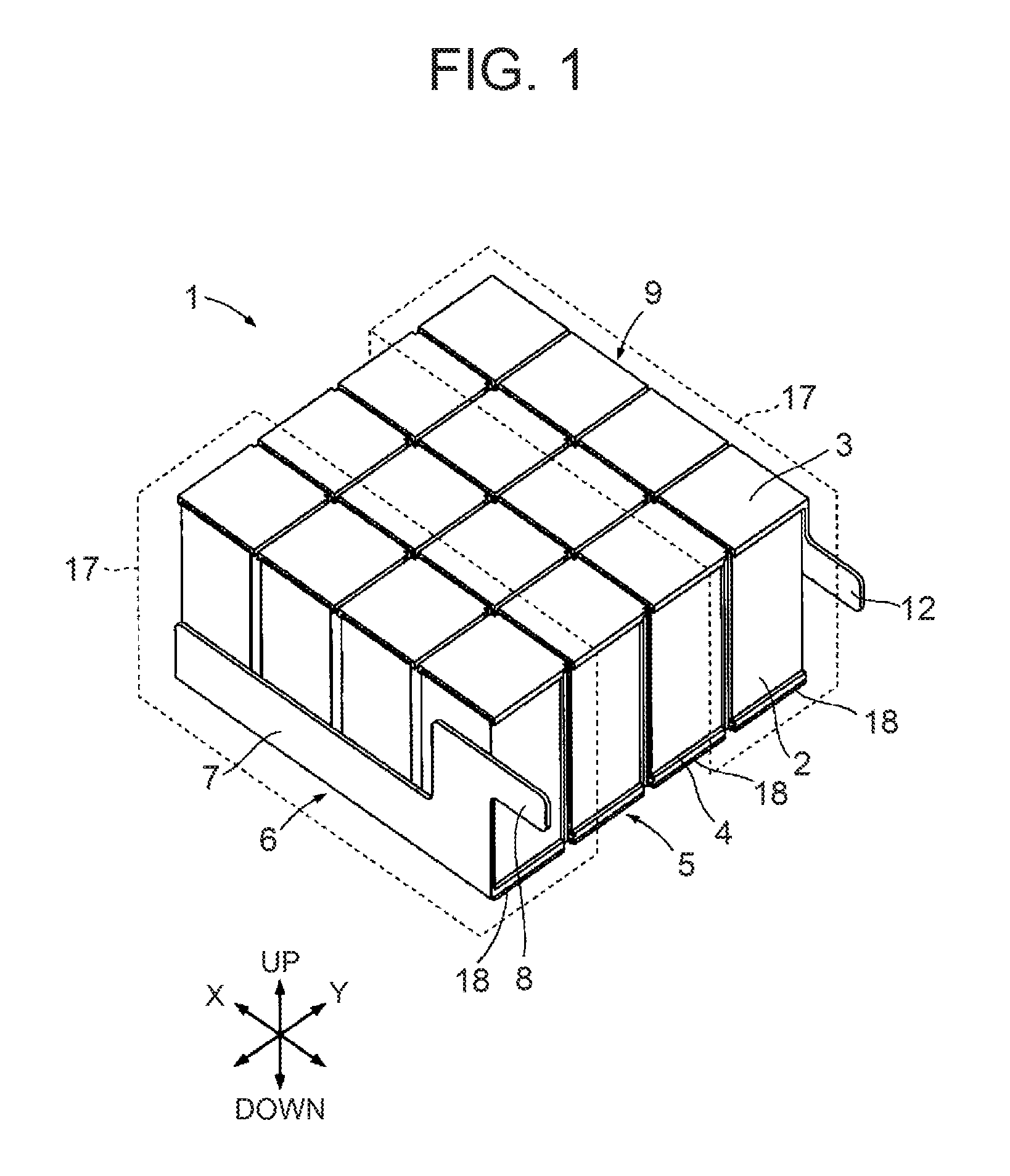Thermoelectric conversion module
- Summary
- Abstract
- Description
- Claims
- Application Information
AI Technical Summary
Benefits of technology
Problems solved by technology
Method used
Image
Examples
first embodiment
[0047]With reference to FIG. 1 through FIG. 5, a description is given of a first embodiment of a thermoelectric conversion module of the present invention. The thermoelectric conversion module shown in FIG. 1 though FIG. 3 is a so-called uni-leg type, in which a plurality of n-type thermoelectric conversion elements 2 are electrically connected.
[0048]The thermoelectric conversion elements 2 are made of magnesium silicide (Mg2Si), shaped into square columns. Conventionally, many of the materials used for thermoelectric conversion elements are toxic (including materials that may become toxic) as well as expensive. By contrast, Mg2Si is not toxic and is environmentally friendly, and moreover is plentiful and inexpensive. In addition, Mg2Si has a low specific gravity, thus allowing very lightweight thermoelectric conversion elements to be produced. For these reasons, Mg2Si has become the material of choice for thermoelectric conversion elements.
[0049]First electrodes 3 are bonded to the...
second embodiment
[0088]Next, with reference to FIG. 7 to FIG. 11, a description is given of a second embodiment of a thermoelectric conversion module of the present invention. Parts that are identical to those of the first embodiment are given the same reference numerals and descriptions thereof are omitted. Reference numeral 217 in FIG. 7 and FIG. 8 denotes parallel groups of the second embodiment.
[0089]As shown in FIG. 7 through FIG. 9, a thermoelectric conversion module 201 of the second embodiment, as described as a variation of the first embodiment above, forms the second electrodes 4 of the Z-shaped member 16 of the thermoelectric conversion module 1 of the first embodiment as an integrated unit in the X direction (see FIG. 9 through FIG. 11) as well as links two thermoelectric conversion modules 1 of the first embodiment together.
[0090]As shown in the proximal end in the Y direction of FIG. 8 (the distal end in the Y direction in FIG. 7 and FIG. 9), the four first electrodes 3 linked together...
third embodiment
[0100]Next, with reference to FIG. 12 through FIG. 14, a description is given of a third embodiment of the present invention. It should be noted that parts that are identical to those of the first or second embodiments are given the same reference numerals and descriptions thereof are omitted. In addition, reference numeral 17′ in FIG. 12 and FIG. 13 denotes series groups of the third embodiment.
[0101]The thermoelectric conversion module 301 of the third embodiment is a so-called pi-type thermoelectric conversion module consisting of n-type thermoelectric conversion elements 2 and p-type thermoelectric conversion elements 2′, electrically connected. As shown in FIG. 12, the elements are arranged p-type, n-type, p-type, n-type, in that order, from the proximal end in the Y direction. In the X direction, four thermoelectric conversion elements of the same type are arrayed.
[0102]In the so-called pi-type thermoelectric conversion module, the p-type thermoelectric conversion element 2′ f...
PUM
 Login to View More
Login to View More Abstract
Description
Claims
Application Information
 Login to View More
Login to View More - R&D
- Intellectual Property
- Life Sciences
- Materials
- Tech Scout
- Unparalleled Data Quality
- Higher Quality Content
- 60% Fewer Hallucinations
Browse by: Latest US Patents, China's latest patents, Technical Efficacy Thesaurus, Application Domain, Technology Topic, Popular Technical Reports.
© 2025 PatSnap. All rights reserved.Legal|Privacy policy|Modern Slavery Act Transparency Statement|Sitemap|About US| Contact US: help@patsnap.com



